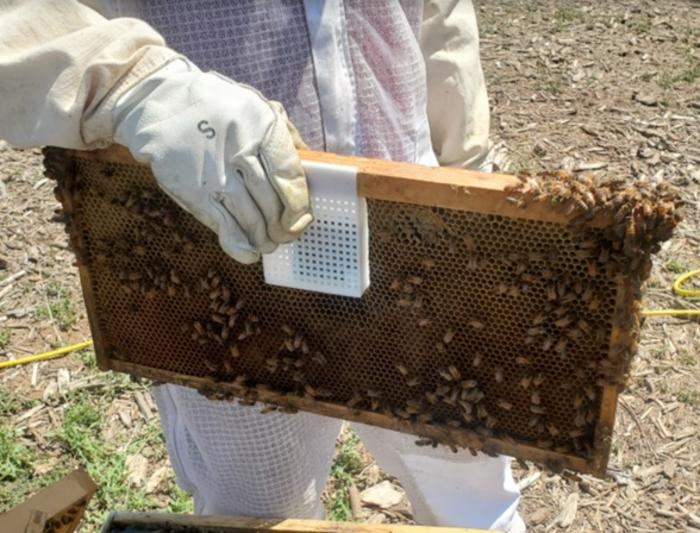As the global ecosystem faces critical challenges, the plight of honeybees has become a pressing concern, with these vital pollinators underpinning a significant portion of human food resources. Despite their essential role in the pollination of crops such as coffee, almonds, and fruits, honeybee populations are declining—from adverse effects of extreme weather conditions, pesticide use, and biological threats such as parasites. Researchers from Carnegie Mellon University’s School of Computer Science, alongside their colleagues at the University of California, Riverside, have now developed a groundbreaking system known as the Electronic Bee-Veterinarian (EBV) to help beekeepers monitor the health of their colonies more effectively.
Beekeeping, traditionally reliant on the intuition and experience of the beekeeper, is often riddled with uncertainties. Beekeepers have to make important decisions based on their observations and knowledge of bee behavior. However, there are limitations to this experience-based approach. Environmental stressors, such as pesticides and climate extremes, disrupt the bees’ natural thermoregulation capability. Honeybees strive to maintain internal hive temperatures between 33 and 36 degrees Celsius through clustering or by fanning their wings to create a cooler environment. However, when these natural thermoregulatory behaviors fail, colonies can enter a state of distress, and beekeepers need data-driven interventions to avert potential collapse.
The EBV is a significant leap forward, utilizing low-cost heat sensors strategically placed inside and outside the hive to record real-time temperature data. The information collected is analyzed through a predictive model that computes a hive health factor. This factor simplifies the intricate data into a single value, providing beekeepers with a clear and actionable insight into the state of their hives. If the health factor approaches one, it indicates that the bees are thriving; conversely, a lower value suggests that intervention is necessary. Such forecasting allows beekeepers to intervene proactively rather than reactively, which could save entire colonies from collapse.
Christos Faloutsos, a leading researcher in the project, elaborated on the scientific foundation of the EBV. He explained that the predictive model is rooted in established principles of thermal diffusion, heat transfer, and control theory. These equations combine historical temperature data with mathematical modeling techniques, yielding a robust hive health factor that can be interpreted easily by any beekeeper who adopts the technology. The design philosophy behind the EBV prioritizes understandability, making it feasible for beekeepers without advanced technical skills to comprehend the implications of the data provided to them.
The collaborative effort brought together a team of multidisciplinary experts, melding computer science with fields like entomology and electrical engineering. This diverse expertise has been central to the project’s innovative outcomes. The research has received funding from the U.S. Department of Agriculture’s National Institute of Food and Agriculture, highlighting its potential agricultural impact. Presentation of their findings at the 2024 SIAM International Conference on Data Mining adds to the credibility and visibility of their work within both scientific and agricultural communities.
Beekeepers’ challenges extend beyond simple hive management; they face a multitude of pressures from disease and environmental changes. Automated systems that leverage technology have been explored in various fields, but the unique requirements of managing live organisms necessitate distinct approaches. The second phase of the EBV project looks at how the data gathered can be utilized to automate hive climate control. This potential advancement could lead to systems capable of autonomously regulating the hive temperature, providing both heating and cooling without the need for continuous human oversight. Such innovations promise to enhance honey production while protecting the bees from stress related to temperature fluctuations and diseases.
Jeremy Lee, a doctoral student involved in the research, emphasizes the importance of applying computer science methodologies in settings that promote real-world applicability. His previous work in using algorithms for social issues, such as human trafficking detection, echoes this ethos of leveraging technical expertise to drive societal benefits. The multilayered approach that merges predictive analytics with practical agriculture is precisely what future research endeavors must embrace if they aim to address complex, multifaceted issues.
As the research progresses and additional phases are contemplated, one significant goal remains clear: to maximize positive outcomes for beekeepers while ensuring the resilience of honeybee populations against threats posed by human activity. The innovative steps taken through the EBV project represent a promising direction in safeguarding these remarkable insects that are crucial for our food supply and ecosystem health.
The implications extend beyond the immediate farmer-focused benefits, showcasing an essential relationship between technology and agriculture. These advancements could reshape practices in beekeeping globally, ultimately affecting not just honey production but broader agricultural productivity as well. Understanding the health of bee colonies through reliable, real-time data could pave the way for improved yields in various crops, supporting both local economies and global markets.
In summary, the collaboration between Carnegie Mellon University and the University of California, Riverside has led to the development of a technology that may revolutionize beekeeping. The EBV represents a shift in how beekeepers can monitor and respond to the health of their hives—empowering them to make informed decisions based on data, rather than relying solely on instinct. This initiative is a testament to the potential of interdisciplinary partnerships in addressing pressing global challenges, combining computer science with ecological stewardship in a manner that is set to yield significant benefits for both humans and the environment alike.
Subject of Research: Development of Electronic Bee-Veterinarian system for hive health monitoring
Article Title: Principled Mining, Forecasting and Monitoring of Honeybee Time Series with EBV+
News Publication Date: 21-Feb-2025
Web References: DOI
References: N/A
Image Credits: Credit: University of California, Riverside
Keywords
Honeybee health, hive monitoring, thermal regulation, predictive modeling, interdisciplinary research, beekeeping technology, agricultural innovation.
Tags: agriculture and bee healthbeekeeping technology innovationsclimate change impact on beescomputer science in beekeepingdata-driven beekeeping solutionsElectronic Bee-Veterinarian systemhoneybee thermoregulation challengesmonitoring honeybee healthpesticide effects on beespollinator decline solutionsprotecting bee populationsresearch on bee conservation





